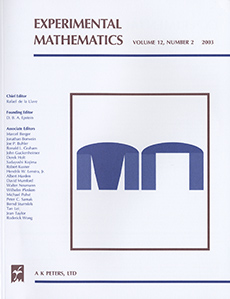Experiment. Math. 7 (1), 37-82, (1998)

KEYWORDS: Mahler measure, polynomials, computation, $L$-function, Elliptic curve, Beilinson conjectures, 11G40, 11R06, 11Y35
If $P(x_1$,\,\dots,\,$x_n)$ is a polynomial with integer coefficients, the Mahler measure $M(P)$ of $P$ is defined to be the geometric mean of $|P|$ over the $n$-torus $\T ^n$. For $n = 1$, $M(P)$ is an algebraic integer, but for $n$\raise.5pt\hbox{\footnotesize\mathversion{bold}${}>{}$}$1$, there is reason to believe that $M(P)$ is usually transcendental. For example, Smyth showed that $\log M(1+x+y)=L'(${\mathversion{normal}$\chi$}$_{-3}$,$\,{-}1)$, where {\mathversion{normal}$\chi$}$_{-3}$ is the odd Dirichlet character of conductor $3$. Here we will describe some examples for which it appears that $\log M(P(x$,$\,y)) = r@@L'(E$,$\,0)$, where $E$ is an elliptic curve and $r$ is a rational number, often either an integer or the reciprocal of an integer. Most of the formulas we discover have been verified numerically to high accuracy but not rigorously proved.

